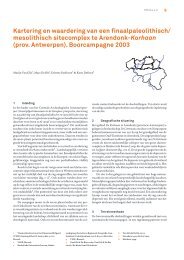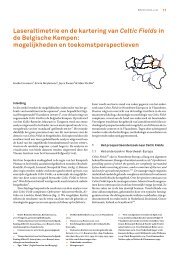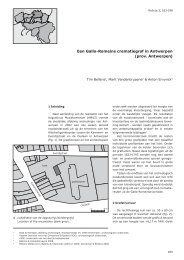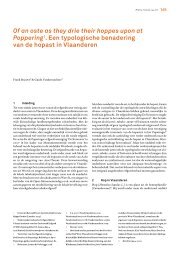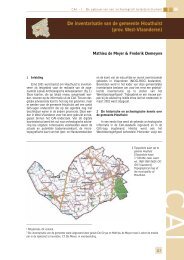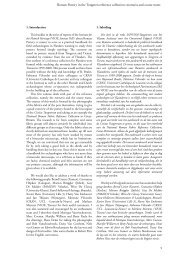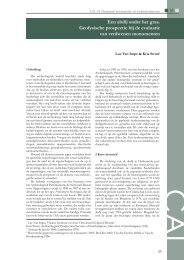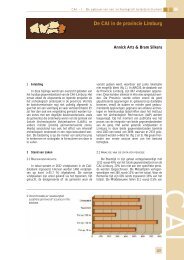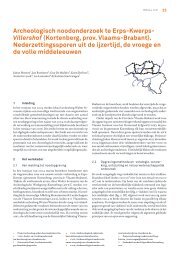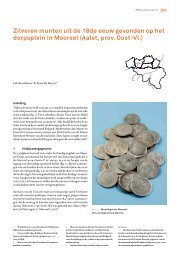Exchanging Medieval Material Culture Studies on archaeology and ...
Exchanging Medieval Material Culture Studies on archaeology and ...
Exchanging Medieval Material Culture Studies on archaeology and ...
You also want an ePaper? Increase the reach of your titles
YUMPU automatically turns print PDFs into web optimized ePapers that Google loves.
116<br />
Hans L. Janssen & Eddie Nijhof<br />
fi g. 20: 1, red ware; Loeff plein kiln: fi g. 29: 2, grey ware <strong>and</strong><br />
fi g. 27: 4, red ware). Some of the red examples from the<br />
Loeff plein kiln are provided with a white slip <strong>on</strong> the inside60.<br />
A sec<strong>on</strong>d group of marginally smaller bowls has the same general<br />
form, having everted, thickened or collared rims, but no<br />
horiz<strong>on</strong>tal h<strong>and</strong>les. Th ey occur in grey ware (Pieterskerk kiln:<br />
fi g. 16: 3; Loeff plein kiln: fi g. 24: 4), but also in red ware. Th ese<br />
large bowls are generally thought to be intended as milk tubs<br />
for the keeping of milk <strong>and</strong> the separati<strong>on</strong> of the cream from<br />
the milk. Nevertheless they could also be c<strong>on</strong>nected with all<br />
sorts of industrial uses.<br />
5.8 Small bowls<br />
Small bowls in red ware occur in modest quantities am<strong>on</strong>g the<br />
fi nds of the Pieterskerk kiln. Th ey were mainly used as table<br />
wares. Th ey have a sagging base, three pinched feet, internal<br />
lead glaze <strong>and</strong> oft en a collared rim with rilling (fi g. 20: 2).<br />
Sometimes everted rims occur (fi g. 20: 4), in <strong>on</strong>e case even a<br />
fl anged rim with horiz<strong>on</strong>tal thumbing (fi g. 20: 3). Very few of<br />
these earlier bowls are provided with a priming white slip <strong>on</strong><br />
the inside (fi g. 20: 3), in <strong>on</strong>e case under a green cupriferous<br />
lead glaze (fi g. 20: 4). Th e small bowls are much more numerous<br />
am<strong>on</strong>g the fi nds of the somewhat later Loeff plein kiln (fi g.<br />
27: 7-9). Th e small bowls from this kiln are characterized by an<br />
internal, sometimes cupriferous lead glaze under a priming of<br />
60 Examples are dblo, inv.nr. 8482, diam. 38 cm (from F-144) <strong>and</strong> dblo, inv.nr. 9546, diam. 37 cm (from F-144).<br />
61 An example is dblo inv.nr. 9589 from F-144.<br />
white slip. In <strong>on</strong>e case (fi g. 27: 8) the cupriferous lead glaze<br />
over the priming has been used <strong>on</strong>ly <strong>on</strong> the outside; the inside<br />
had a lead glaze. Th e bowls have a bewildering variety of<br />
shapes. Th ey occur with no, <strong>on</strong>e or two vertical rod h<strong>and</strong>les <strong>on</strong><br />
the side or <strong>on</strong> the upper side of the rim (fi g. 27: 7-9; fi g. 28: 2)<br />
<strong>and</strong> (oft en) a pulled lip. Th e rims are mostly simple <strong>and</strong> slightly<br />
inverted. In <strong>on</strong>e case the rim is fl anged with horiz<strong>on</strong>tal thumbing<br />
(fi g. 27: 7).<br />
A rarity is the fact that in the earlier Pieterskerk kiln, excavated<br />
in 1984, a few small bowls occur, made from white-fi ring clay,<br />
which are discussed later (fi g. 23: 4-5). Th eir morphology does<br />
not diff er very much from the red ware examples.<br />
5.9 Dishes<br />
Small quantities of red ware dishes with a fl anged rim, st<strong>and</strong>ing<br />
<strong>on</strong> three pinched feet, were encountered am<strong>on</strong>g the waste<br />
of both kiln sites. Th e inside of the dishes is always glazed <strong>and</strong><br />
generally decorated with slip-trailed arcs, dots <strong>and</strong> blobs (fi g.<br />
20: 5; fi g. 27: 6). Once, in the Loeff plein kiln, a stylized fl ower<br />
motif occurs (fi g. 27: 5). Some dishes from the Loeff plein kiln<br />
are provided with a priming of white slip before being glazed<br />
with (oft en) a cupriferous lead glaze61. Th e sgrafi tto technique<br />
does not seem to have been used for dishes in neither of the<br />
two kilns.<br />
Fig. 23 Pieterskerk kiln. Whiteware: 1: small jug with cupriferous lead glaze (F-35, inv.nr. 2739); 2: small jug with cupriferous lead glaze<br />
(F-35, inv.nr. 2740); 3: small jug with lead glaze <strong>and</strong> decorati<strong>on</strong>s in slip-trailed red-fi ring clay (F-35, inv.nr. 2741); 4: small bowl with<br />
lead glaze <strong>on</strong> the inside (F-38, inv.nr. 403); 5: small bowl with cupriferous lead glaze <strong>on</strong> the inside (F-35, inv.nr. 2742). Scale 1:4.<br />
Drawing J-E. Dilz.



